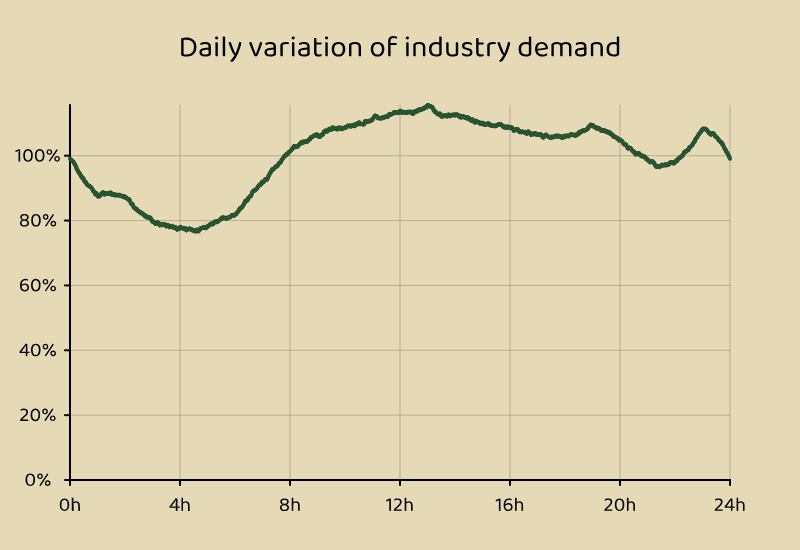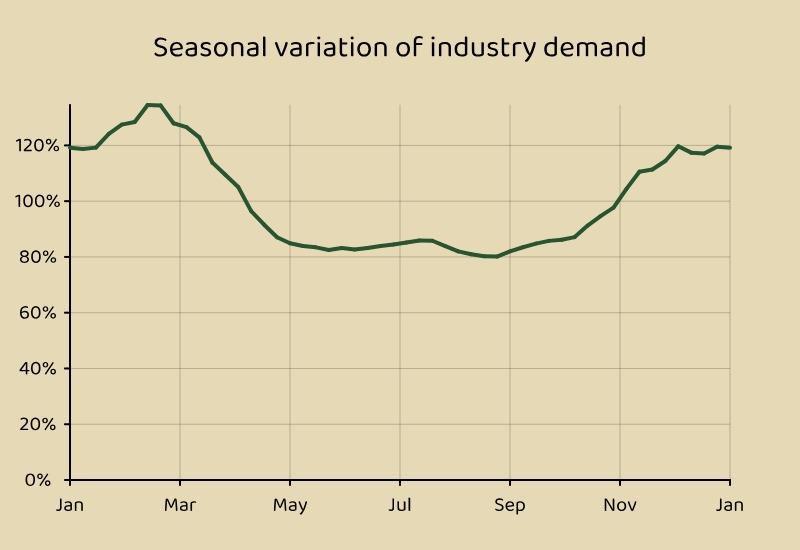Functional Facilities in Energetica are distinct from power, storage, and extraction facilities as they operate on a level-based system. Each upgrade to a higher level incurs increasing costs in terms of construction price, time, and energy.
For more information about building functional facilities, see Starting a Project.
There are four unique functional facilities:
The Industry
The Industry serves as a central element in the game, initially starting at level 1. It generates revenue by consuming
electricity. With each level upgrade, revenue increase by 33%
and electricity demand increases by 40%. It is worth
noting that because of these rates, the industries economic efficiency (in /MWh) is decreasing with higher levels of industry.
Revenues and power demand gradually increase during the upgrade duration.
The electricity demand of the industry fluctuates daily and yearly (in-game time), following specific cycles represented in the following graphs. Energy demand is calculated based on these factors as follows :
-
\( D = D_{base} \times dv(t) \times sv(t) \)
with \(D_{base}\) the base demand as indicated on the page Functional facilities, \(dv()\) the daily variations shown in the following graph, \(sv()\) the seasonal variations shown in the following graph and \(t\) the in-game date and time ( 1 in-game year = 9 real-time days).


If the industry's demand isn't met, revenues are proportional to the satisfaction level.
The Laboratory
The laboratory is needed for researching technologies. Different technology levels require corresponding laboratory levels. It also enhances research speed by 10% and for every 3rd upgrade, a new lab worker is unlocked.
The Warehouse
The warehouse is essential for storing natural resources. Each level increment increases the maximum storage capacity by 50% for all resources. The following table defines the initial storage capacities at level 1.
| Resource | Initial capacity |
|---|---|
| Coal | 3'000 tons |
| Gas | 1'000 tons |
| Uranium | 5 tons |
Carbon Capture
The carbon capture facility consumes electricity to extract CO2 from the atmosphere and store it underground.
With each level upgrade, CO2 absorption increase by 55%
and power consumption increases by 50%.
Contrary to the industry, CO2 absorption is more efficient with higher carbon capture levels.
The absorption rate of CO2 is proportional to the amount of CO2 in the atmosphere witch make it harder to absorb CO2
when its concentration is low.
The CO2 absorption rate and power consumption with carbon capture levels higher than 0 is calculated as follows:
-
\( ar_{CO_2} = ar_{base} \times q_{CO_2,atm} \times 1.55^{CC} \)
\( P_{CC} = P_{base} \times 1.5^{CC} \)
with:- \(ar_{CO_2}\) : CO2 absorption rate in kg/h
- \(ar_{base}\) : base value for fraction of CO2 that can be absorbed from the atmosphere : 2.0833333333333336e-07/h
- \(q_{CO_2,atm}\) : amount of CO2 in the atmosphere in kg
- \(CC\) : level of Carbon Capture
- \(P_{CC}\) : power consumed by carbon capture
- \(P_{base}\) : base power consumption of carbon capture :